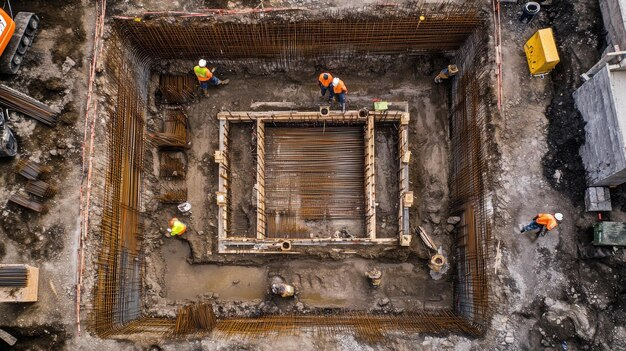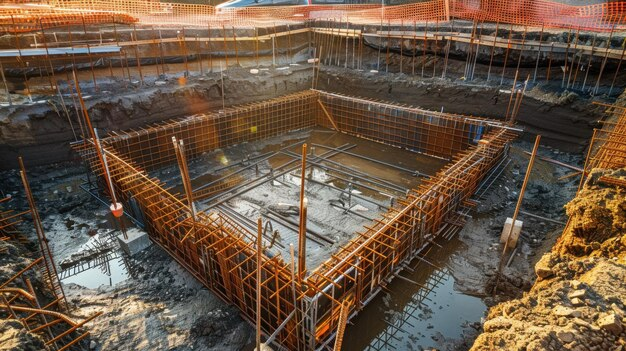A foundation helps shed the load of a structure to the ground, brings firmness to the structure and prevents it from sinking or collapsing. There are sundry kinds of foundation depending on such conditions as the kind of soil, local climate, and design of the structure. In India itself; the nature of the soil may further range from sandy, clayey, and so on; some parts of the country are also vulnerable to earthquakes; the decision on type of foundation is therefore paramount. Seismic analysis of buildings also comes to the structural engineer’s mind in addition to ensuring that the buildings are compliant with the legal requirements of the area in terms of its foundation.
Types of Foundations in Civil Engineering
In India, construction primarily uses two foundation types, with the choice influenced by soil type and building requirements:
- Shallow Foundation
- Deep Foundation
This guide explores deep foundations, detailing their types, benefits, and challenges for various construction needs.
What is Deep Foundation?

A deep foundation transfers a structure’s load far below the surface, with a depth-to-width ratio greater than 4 to 5. Deep foundations are used when load-bearing soil is not accessible at shallow depths, ensuring stability for large or heavy structures. Examples include high-rise buildings, bridges, and infrastructure in challenging soil conditions.
Types of Deep Foundations
Pile Foundations
Pile foundations involve vertical columns (or piles) driven, drilled, or cast into the ground to support structures by transferring loads to stable soil or bedrock layers. In India, these are especially useful in varying soil types and are essential for achieving stability.
Caisson or Well Foundations
Commonly cylindrical, caissons support massive structures like piers and bridges. Built underwater, they stabilize structures in challenging terrains with high water tables or eroding soils, though they require thorough technical assessments.
Basement Foundations
Used for structures with one or more floors below ground, basement foundations support multi-use spaces. Unlike other deep foundations, these allow for “finished” spaces like extra rooms beneath the main structure.
Buoyancy Rafts
A buoyancy raft foundation reduces settlement by balancing the weight of the structure with the weight of excavated soil. These are also known as compensated foundations.
Shaft Foundations (Drilled Piers)
Also known as drilled piers, shaft foundations involve boring cylindrical holes, inserting reinforcement cages, and filling them with concrete. They are ideal for sites with available drilling equipment and support up to 76 meters deep.
Advantages of Deep Foundations
- Load-Bearing Capacity: Reaches stable soil or bedrock layers to support heavy structures.
- Stability in Weak Soils: Transfers loads away from weak soil layers, preventing settlement issues.
- Mitigates Settlement: Reduces the risk of uneven settlement and structural damage.
- Design Flexibility: Can be tailored to specific project requirements.
- Seismic Resistance: Provides resilience against earthquakes, especially when extending into bedrock.
- Lateral Force Resistance: Foundations like sheet piles resist lateral forces, crucial for sites near slopes or water bodies.
Disadvantages of Deep Foundations
- Cost: More expensive than shallow foundations due to materials, labor, and equipment needs.
- Time-Consuming: Installation is slower, impacting project timelines.
- Noise and Vibration: Driven piles produce noise and vibrations that may disrupt nearby areas.
- Risk of Subsurface Unknowns: Unpredictable underground conditions can complicate installation.
- Maintenance Challenges: Access for maintenance is difficult, requiring specialized equipment and expertise.
Conclusion
Piled or deep foundations are important participants in civil engineering practice and provide support and load bearing requirements for structures found in difficult soil conditions. That being said, the alternatives give higher support while the cost, installation process involving large manpower and their hazards to the environment have to be considered more. They have to consider these factors while deciding whether deep foundations are suitable considering factors such as the type of soil in the area and the water table, the kind of structure that has to be built in that area among others.
However, despite the challenges mentioned, deep foundations are essential for various construction projects, including high-rise buildings, bridges, and other critical infrastructural developments. Walls and Dreams emphasizes the importance of choosing the right foundation type to ensure stability and longevity in your construction endeavors.








